
The Time Machine is an 1895 dystopian post-apocalyptic science fiction novella by H. G. Wells about a Victorian scientist known as the Time Traveller who travels to the year 802,701. The work is generally credited with the popularization of the concept of time travel by using a vehicle or device to travel purposely and selectively forward or backward through time. The term "time machine", coined by Wells, is now almost universally used to refer to such a vehicle or device.
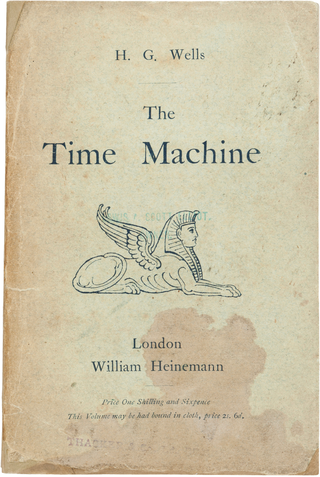
Time travel is the hypothetical activity of traveling into the past or future. Time travel is a concept in philosophy and fiction, particularly science fiction. In fiction, time travel is typically achieved through the use of a device known as a time machine. The idea of a time machine was popularized by H. G. Wells's 1895 novel The Time Machine.
" '—All You Zombies—' " is a science fiction short story by American writer Robert A. Heinlein. It was written in one day, July 11, 1958, and first published in the March 1959 issue of The Magazine of Fantasy & Science Fiction after being rejected by Playboy.

The Time Ships is a 1995 hard science fiction novel by Stephen Baxter. A canonical sequel to the 1895 novella The Time Machine by H. G. Wells, it was officially authorized by the Wells estate to mark the centenary of the original's publication. The Time Ships won critical acclaim. It won the John W. Campbell Memorial Award and the Philip K. Dick Award in 1996, as well as the British Science Fiction Association Award in 1995. It was also nominated for the Hugo, Clarke and Locus Awards in 1996.

A Connecticut Yankee in King Arthur's Court is an 1889 historical novel by American humorist and writer Mark Twain. The book was originally titled A Yankee in King Arthur's Court. Some early editions are titled A Yankee at the Court of King Arthur.

Vril: The Power of the Coming Race, originally published as The Coming Race, is a novel by Edward Bulwer-Lytton, published anonymously in 1871.
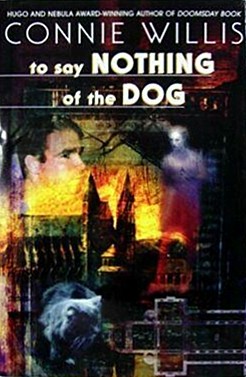
To Say Nothing of the Dog: or, How We Found the Bishop's Bird Stump at Last is a 1997 comic science fiction novel by Connie Willis. It uses the same setting, including time-traveling historians, which Willis explored in Fire Watch (1982),Doomsday Book (1992), and Blackout/All Clear (2010).
Edisonade is a genre of fictional stories about a brilliant young inventor and his inventions, many of which would now be classified as science fiction. This subgenre started in the Victorian and Edwardian eras and had its apex of popularity during the late 19th and early 20th centuries. Other related terms for fiction of this type include scientific romances. The term was introduced in 1993 by John Clute in his and Peter Nicholls' The Encyclopedia of Science Fiction. It is an eponym, named after famous inventor Thomas Edison, formed in the same way the term "Robinsonade" was formed from Robinson Crusoe.

The Time Traveler's Wife is the debut novel by American author Audrey Niffenegger, published in 2003. It is a love story about Henry, a man with a genetic disorder that causes him to time travel unpredictably, and about Clare, his wife, an artist who has to cope with his frequent absences. Niffenegger, who was frustrated with love when she began the novel, wrote the story as a metaphor for her failed relationships. The tale's central relationship came to Niffenegger suddenly and subsequently supplied the novel's title. The novel has been classified as both science fiction and romance.
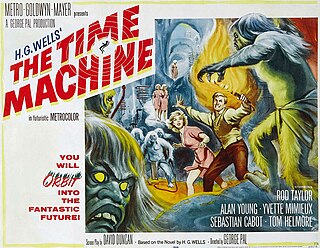
The Time Machine is a 1960 American period post-apocalyptic science fiction film based on the 1895 novella of the same name by H. G. Wells. It was produced and directed by George Pal, and stars Rod Taylor, Yvette Mimieux, and Alan Young. The story is set in Victorian England and follows an inventor who constructs a machine that enables him to travel into the distant future. Once there, he discovers that mankind's descendants have divided into two species, the passive, childlike, and vegetarian Eloi and the underground-dwelling Morlocks, who feed on the Eloi.

Enrique Lucio Eugenio Gaspar y Rimbau was a Spanish diplomat and writer, who wrote many plays (zarzuelas), and one of the first novels involving time travel with a time machine, El anacronópete.
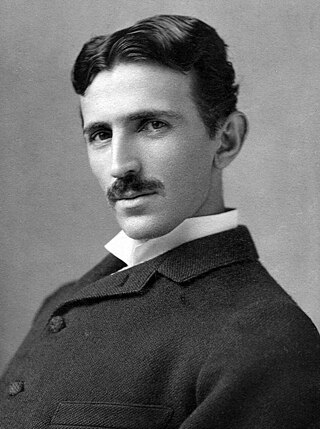
Nikola Tesla is portrayed in many forms of popular culture. The Serbian-American engineer has particularly been depicted in science fiction, a genre which is well suited to address his inventions; while often exaggerated, the fictionalized variants build mostly upon his own alleged claims or ideas. A popular, growing fixation among science fiction, comic book, and speculative history storytellers is to portray Tesla as a member of a secret society, along with other luminaries of science. The impacts of the technologies invented by Nikola Tesla are a recurring theme in the steampunk genre of alternate technology science-fiction.

H. G. Wells was a prolific writer of both fiction and non-fiction. His writing career spanned more than sixty years, and his early science fiction novels earned him the title of "The Father of Science Fiction".
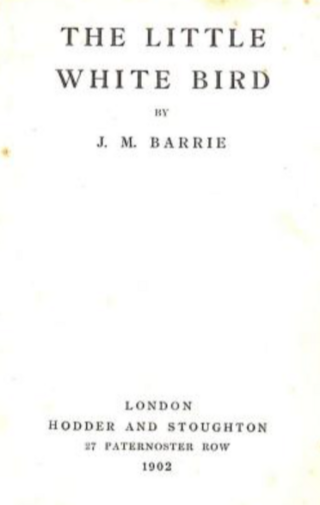
The Little White Bird is a novel by the Scottish writer J. M. Barrie, ranging in tone from fantasy and whimsy to social comedy with dark, aggressive undertones. It was published in November 1902, by Hodder & Stoughton in the UK and Scribner's in the US. The book attained prominence and longevity thanks to several chapters written in a softer tone than the rest of the book, which introduced the character and mythology of Peter Pan. In 1906, those chapters were published separately as a children's book, Peter Pan in Kensington Gardens.
"Fire Watch" is a science fiction novelette by American writer Connie Willis. The story, first published in Isaac Asimov's Science Fiction Magazine in February 1982, involves a time-traveling historian who goes back to the Blitz in London, to participate in the fire lookout at St Paul's Cathedral.
Rudolph Fentz is the focal character of "I'm Scared", a 1951 science fiction short story by Jack Finney, which was later reported as an urban legend as if the events had truly happened. The story tells of a 19th-century-looking young man possessing items of that period who is found confused in the middle of Times Square in the 1950s before being hit by a motorist and killed, suggesting that he had, perhaps involuntarily, time travelled about a century forwards.

The War of the Worlds is a science fiction novel by English author H. G. Wells. It was written between 1895 and 1897, and serialised in Pearson's Magazine in the UK and Cosmopolitan magazine in the US in 1897. The full novel was first published in hardcover in 1898 by William Heinemann. The War of the Worlds is one of the earliest stories to detail a conflict between humankind and an extraterrestrial race. The novel is the first-person narrative of an unnamed protagonist in Surrey and his younger brother who escapes to Tillingham in Essex as London and Southern England are invaded by Martians. It is one of the most commented-on works in the science fiction canon.
The idea of a fourth dimension has been a factor in the evolution of modern art, but use of concepts relating to higher dimensions has been little discussed by academics in the literary world. From the late 19th century onwards, many writers began to make use of possibilities opened up by the exploration of such concepts as hypercube geometry. Some writers took the fourth dimension to be one of time, which is consistent with the physical principle that space and time are fused into a single continuum known as spacetime. Others preferred to think of the fourth dimension in spatial terms, and some associated the new mathematics with wider changes in modern culture.
"The Clock That Went Backward" is a fantasy short story by American writer Edward Page Mitchell.












